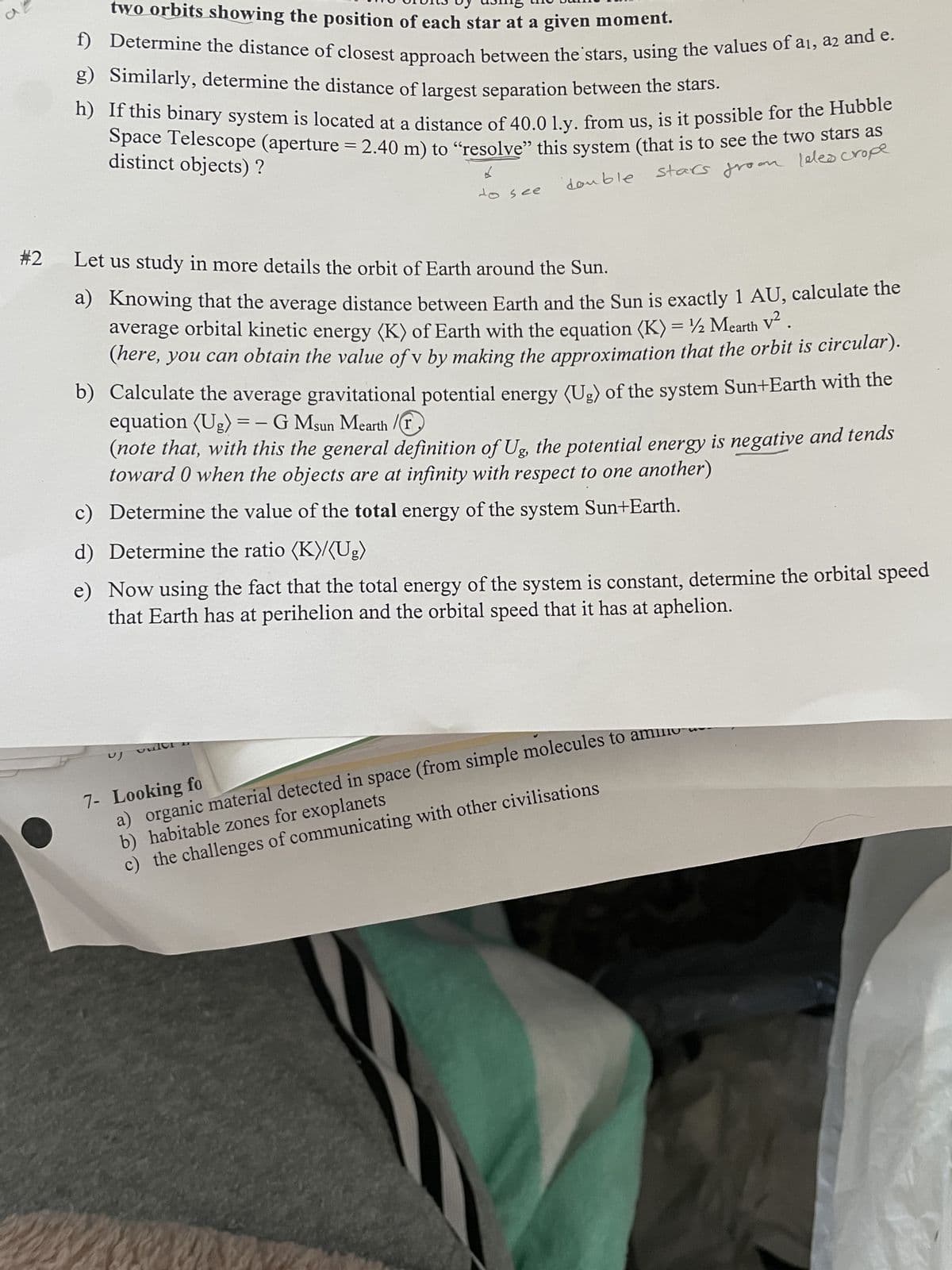#2 Let us study in more details the orbit of Earth around the Sun. a) Knowing that the average distance between Earth and the Sun is exactly 1 AU, calculate the average orbital kinetic energy (K) of Earth with the equation (K) = ½ Mearth v². (here, you can obtain the value of v by making the approximation that the orbit is circular). b) Calculate the average gravitational potential energy (Ug) of the system Sun+Earth with the equation (Ug) = - G Msun Mearth / (note that, with this the general definition of Ug, the potential energy is negative and tends toward 0 when the objects are at infinity with respect to one another) Determine the value of the total energy of the system Sun+Earth. c) d) Determine the ratio (K)/(Ug) e) Now using the fact that the total energy of the system is constant, determine the orbital speed that Earth has at perihelion and the orbital speed that it has at aphelion.
#2 Let us study in more details the orbit of Earth around the Sun. a) Knowing that the average distance between Earth and the Sun is exactly 1 AU, calculate the average orbital kinetic energy (K) of Earth with the equation (K) = ½ Mearth v². (here, you can obtain the value of v by making the approximation that the orbit is circular). b) Calculate the average gravitational potential energy (Ug) of the system Sun+Earth with the equation (Ug) = - G Msun Mearth / (note that, with this the general definition of Ug, the potential energy is negative and tends toward 0 when the objects are at infinity with respect to one another) Determine the value of the total energy of the system Sun+Earth. c) d) Determine the ratio (K)/(Ug) e) Now using the fact that the total energy of the system is constant, determine the orbital speed that Earth has at perihelion and the orbital speed that it has at aphelion.
Related questions
Question
#2 c, d, e

Transcribed Image Text:a
#2
two orbits showing the position of each star at a given moment.
f) Determine the distance of closest approach between the stars, using the values of ai, a2 and e.
g) Similarly, determine the distance of largest separation between the stars.
h) If this binary system is located at a distance of 40.0 1.y. from us, is it possible for the Hubble
Space Telescope (aperture = 2.40 m) to "resolve" this system (that is to see the two stars
distinct objects) ?
stars from leles crope
6
double
to see
Let us study in more details the orbit of Earth around the Sun.
a) Knowing that the average distance between Earth and the Sun is exactly 1 AU, calculate the
average orbital kinetic energy (K) of Earth with the equation (K) = 1/2 Mearth V²
(here, you can obtain the value of v by making the approximation that the orbit is circular).
b) Calculate the average gravitational potential energy (Ug) of the system Sun+Earth with the
equation (Ug) = - G Msun Mearth /
(note that, with this the general definition of Ug, the potential energy is negative and tends
toward 0 when the objects are at infinity with respect to one another)
c) Determine the value of the total energy of the system Sun+Earth.
d) Determine the ratio (K)/(Ug)
e)
Now using the fact that the total energy of the system is constant, determine the orbital speed
that Earth has at perihelion and the orbital speed that it has at aphelion.
7- Looking fo
a) organic material detected in space (from simple molecules to ammo
b) habitable zones for exoplanets
c) the challenges of communicating with other civilisations
UJ
vulor
Expert Solution
This question has been solved!
Explore an expertly crafted, step-by-step solution for a thorough understanding of key concepts.
Step by step
Solved in 3 steps
